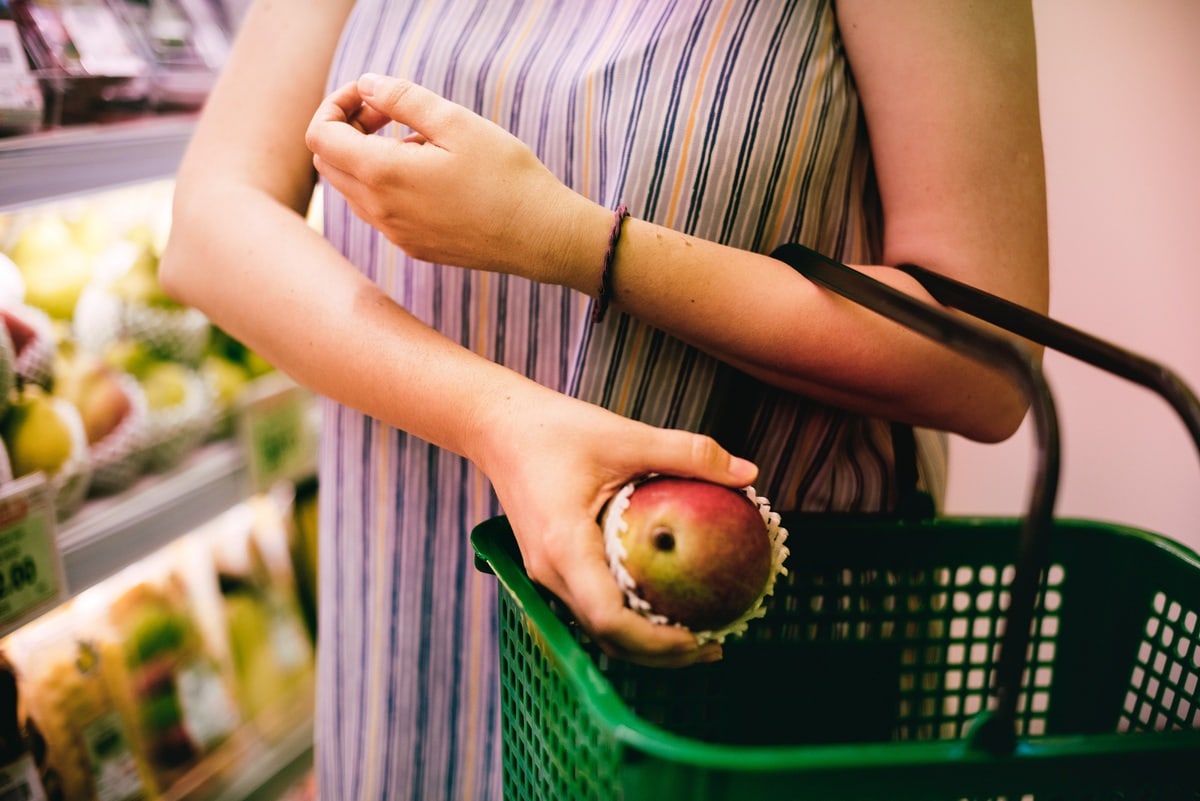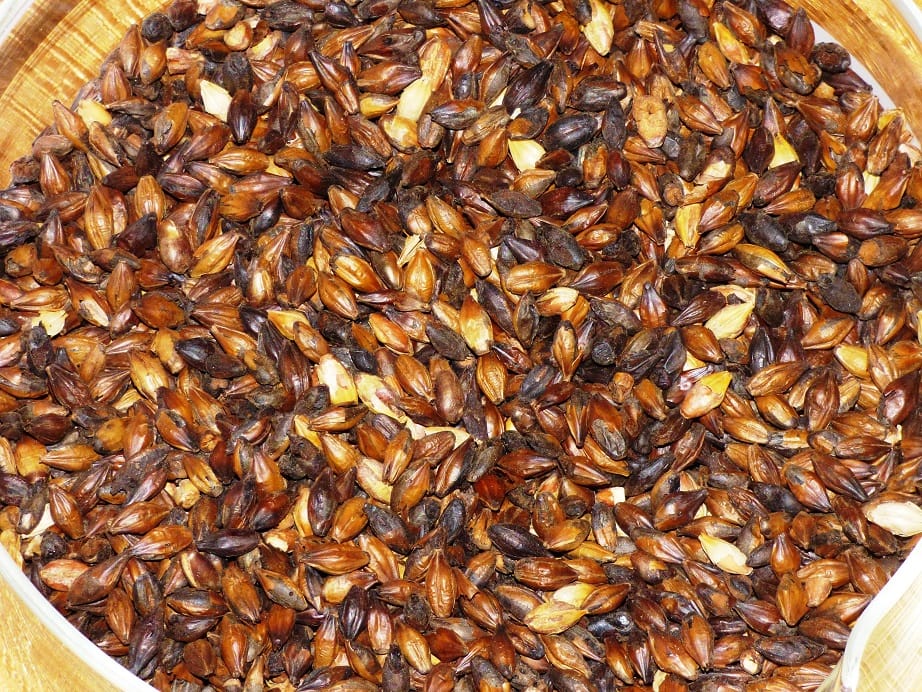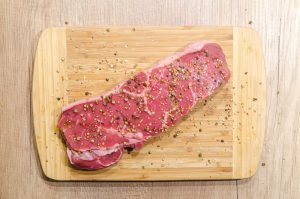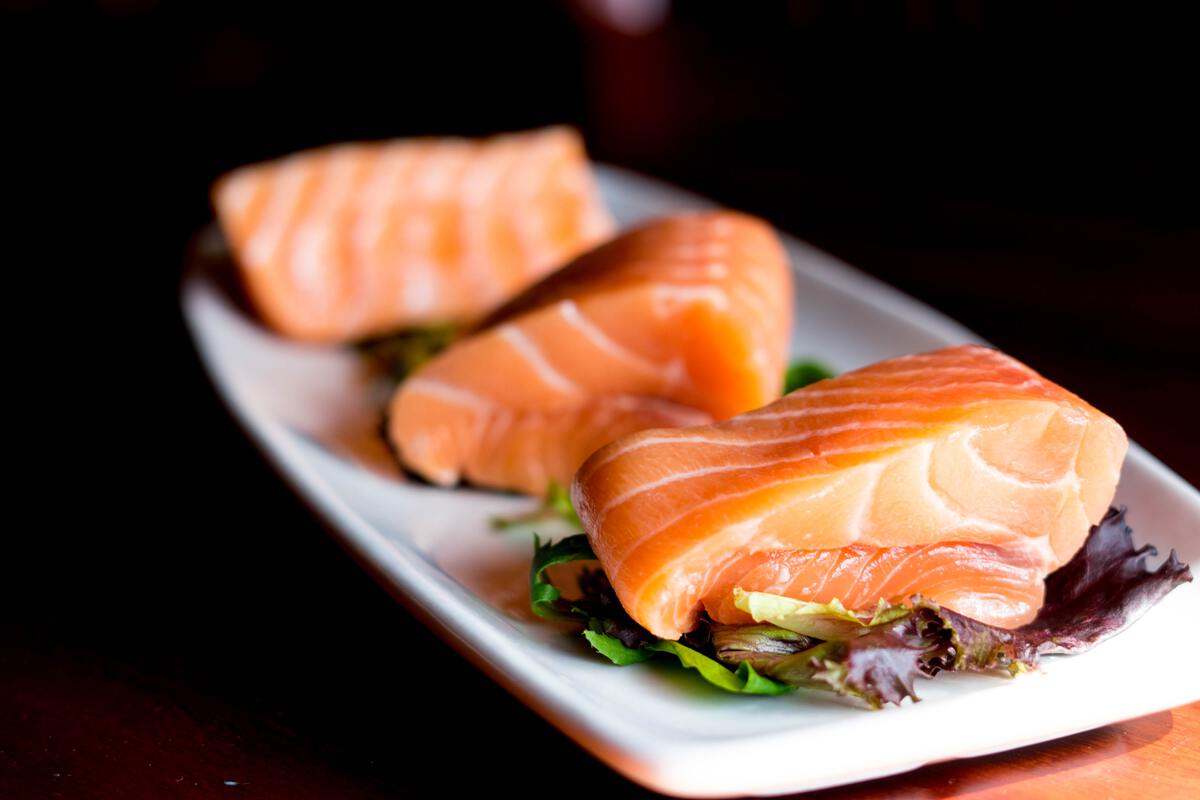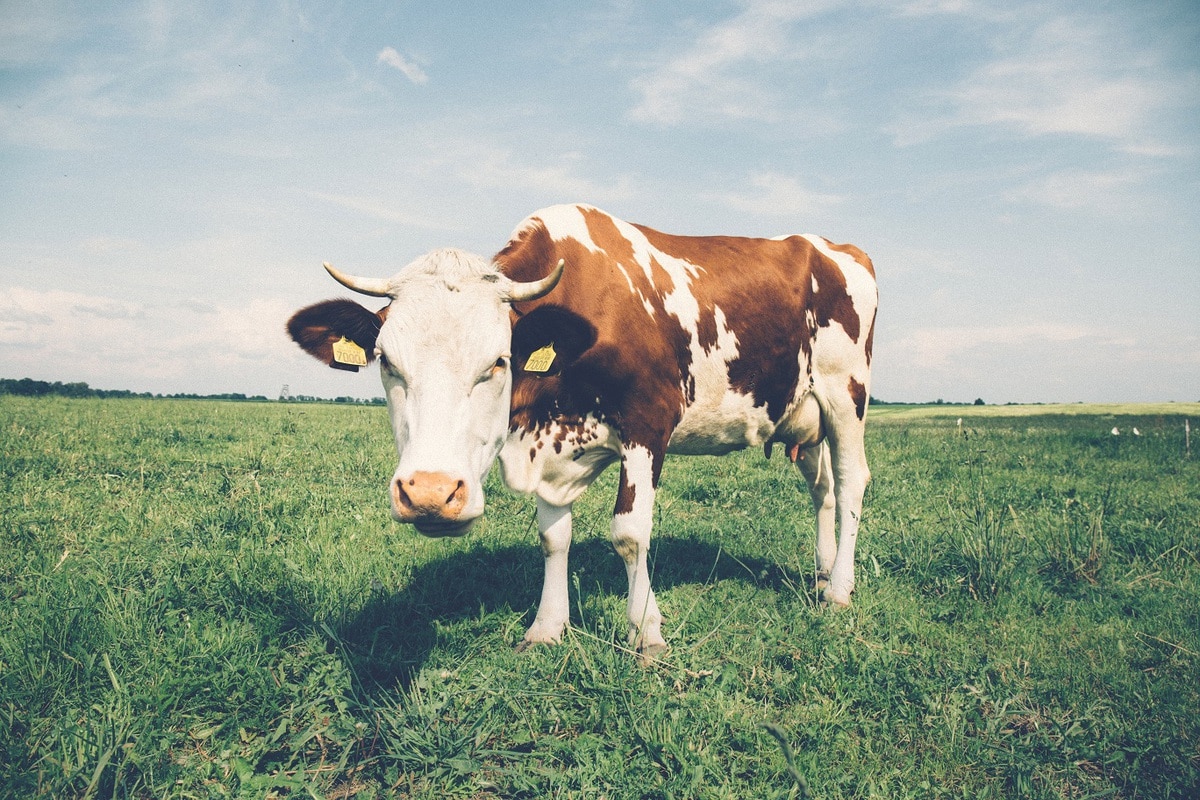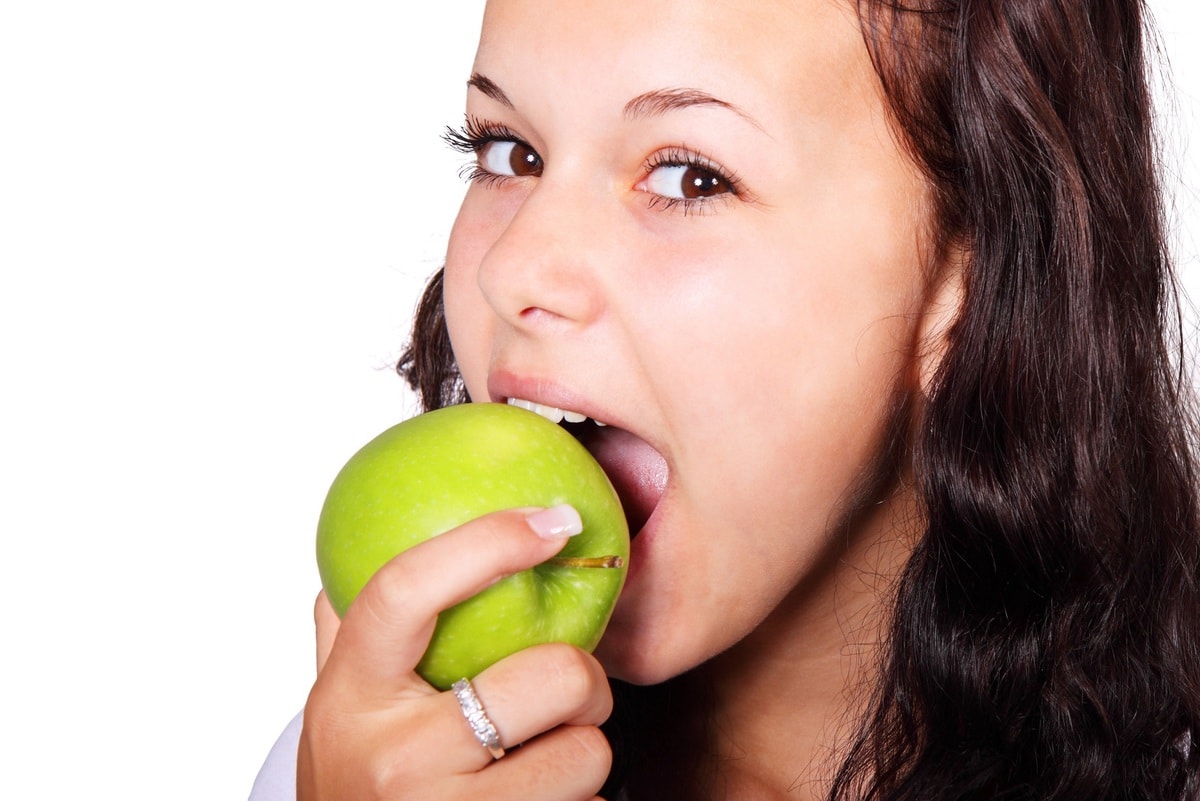It’s so easy to over-indulge. But what’s even easier is the detriment too much of a good thing can have on your health. The fact that you’re reading this very sentence means you’re already aware of this and want to do something about it. It’s the best first step you can take. For the second step, let’s provide you with a healthy grocery list template.
Top Rated Shopping List App
Share And Synchronize An Unlimited Number
Of Lists With Others Instantly and Easy
As well as informing you what food you’ll need to be switching to, we want to make sure you know why you’re switching products. Armed with this healthy grocery list and the knowledge behind it, you’ll be ready to fight for a healthier lifestyle and a better you.
However, if you’d rather skip straight to the healthy grocery list, you can download a free printable version here.
 What to Substitute
What to Substitute
Most of what makes up a healthy eating grocery list is substituting what you already have on your food shopping list for a better alternative. So, we want to take the time to talk about what and why you’re making these substitutions.
Go for Gold Bronze
One of the simplest changes to make in order to create a healthy grocery list is to switch your usual carbs for wholemeal or wholegrain alternatives.
That’s not to say white pasta and white bread are bad for you: they’re fine! It’s just that wholemeal and wholegrain versions are better for you.
Why? Because they’re full of fiber.
The best thing about fiber is that it keeps you feeling full after eating it. This means, that if you’re also on a calorie deficit diet, you’re not going to get those hunger pangs as quickly. Fiber is also great for the following:
- Lowering cholesterol
- Reducing the risk of heart disease
- Regulating your blood sugar
However, do be prepared for these to take longer to cook than their paler counterparts.
A Meaty Dilemma
Being healthier doesn’t mean you can’t have meat. But it does mean you need to more careful about the type of meat you eat.
There are two types of meat you’ll want to avoid:
- Red meat
- Beef
- Pork
- Mutton
- Processed meat
- Ham
- Bacon
- Sausages
- Dried meat
- Cured meat
Red meat has high levels of saturated fat which is strongly linked with high cholesterol and heart disease. Eating too much processed meat over a long period of time can increase your risk of bowel and stomach cancer, and has been linked with other diseases such as heart disease and high blood pressure/hypertension.
However, evidence keeps coming to light that paints a slightly more complicated picture about whether red and processed meat are as bad for you as first thought. But it’s based to err on the side of caution, especially if you’re really keen on becoming a healthier version of you.
Meat you should be going for is white meat, such as turkey or chicken, which you can also buy in ground/minced form. When you buy fillets, go for skinless varieties, as the skin itself holds a lot of saturated fat.
But that doesn’t mean you must cut red and processed meat completely out. If you still fancy having red meat, just be sure to buy leaner cuts or ground/minced meat with lower fat content. This will make sure you’re not getting too much saturated fat into your system.
If you really fancy drastically cutting back meat from your diet, we highly recommend replacing it with legumes. This is because these have a high protein content meaning you don’t lose out on these essentials nutrients. As they’re also full of fiber, they’ll help you stay full for longer, as well as pump you full of amazing B-Vitamins.
For more information about decreasing the meat on your healthy grocery list and increasing your legume intake, be sure to read out “5 Reasons to Be On A Flexitarian Diet” guide.
Fishy Business
One thing you should definitely be including on your healthy grocery list is fish. But not just any old fish: oily fish.
There isn’t anything wrong with non-oily fish: they’re still a great source of protein and contains many minerals and vitamins. However, oily fish contain a lot of omega 3 oils, which are attributed to:
- Lowering the risk of heart disease
- Reducing cholesterol
- Improving memory
- Reducing the risk of dementia
- Preventing cancer
In the UK, the National Health Service recommends eating two portions of fish a week as part of your healthy meals, with one of them being made of oily fish.
Don’t Milk It
Milk is something that many of us have day in and day out. So it’s no surprise that making some changes to the milk you use can also result in better healthy eating. Like with other food, going for low-fat versions of dairy products will help you get healthier quicker.
So swap that creamy full-fat milk for semi-skimmed (half and half), or even go the whole hog and go skimmed (1%)!
You can even try replacing mammal milk with milk alternatives, like almond or soya milk. But be careful. Different types of milk alternatives have varying amounts of protein, fat, and nutrients compared to each other as well as animal milk. But these are certainly the way forward if you’re worried about the dairy industry’s impact on the environment or the treatment of animals in the production of milk and milk products.
Fight (Bad) Fat with (Good) Fat
Whilst we’ve spent some time extolling the virtues of cutting down your intake of saturated fat, not all fat is bad for you. Indeed, fat contains some of the proteins that are required to make our body function properly.
Therefore, when making a healthy grocery list, you need to make sure you’re getting the right kind of fat. You can do this by replacing your usual fatty products, such as oils and spreads, with ones that are better for you.
Regarding oil, it’s best to steer away from vegetable oil and opt for rapeseed, linseed, or olive oil. That’s because all these contain omega-3 like you find in oily fish.
For things like spreads, consider swapping out butter for margarine on your healthy food list. You can also find spreads which have been infused with healthy oil, like olive oil, to ensure you get extra benefits beyond simply reducing your saturated fat intake.
Be Bitter About Sugar
As much as saturated fat has gotten the blame for a whole host of problems for quite some time, people are now starting to put refined sugar under scrutiny. Calories from sugar that don’t get used up get turned into body fat. Too much sugar can also cause type 2 diabetes. Therefore, the amount of sugar added to food during processing has started to be blamed for large increases in obesity.
This means you should also be making sure as much refined sugar stays off your healthy grocery list. The problem is every loves a sweet treat and craves sugary goodness from time to time.
But there are a few ways to stave off these urges.
- Freeze some grapes – these can provide a chilly and tasty treat
- Go dark with your chocolate – if you love chocolate, chances are this is going to be difficult to give up. Instead, start eating more dark chocolate. Higher cocoa content means there’s more of the bitter main ingredient that makes up chocolate, and less added refined sugar and oil.
- FroYo because YOLO – frozen yogurt is a great alternative to ice cream because it contains a lot less saturated fat. But be careful not to over-indulged, as some types can still contain a lot of refined sugar.
- Eat fruit or veg-based cakes – As fruit and veg can are natural sources of natural sugar, they can be used to sweeten some things instead of refined sugar. If you fancy some cake (and let’s face it, who doesn’t), try carrot, beetroot, banana, or zucchini cake, to name but 4 possibilities. The natural sugars contained in the vegetables and fruit used will either replace or lower the need for refined sugar to be added. What’s more, these are also higher in fiber and vitamins making them all-around healthier cakes. In some cases, the high fruit/veg content means a slice could contain a full portion of your greens!
Survive a Snack Attack
One of the biggest issues with dieting is the hunger pangs. It’s highly likely you’re going to feel the urge to snack, especially if you’re on a calorie deficit diet. But that’s ok. If you are going to snack, it’s best to make sure that what you’re eating between meals isn’t going to undo your hard work. Even if you’re not dieting and just wanting to become healthier, this is a great way to stay on the straight and narrow.
- Air-popped popcorn – this is a great alternative to chips/crisps. Popcorn is a light, low in calories, and come as either savory or sweet snacks.
- Fresh Fruit – this is hardly big news, but eating some fresh fruit is still one of the best ways to snack. Our only advice is to be honest with yourself with the amount you buy. The last thing you’ll want to do is buy so much that you end up with food waste instead of a trim waist.
- Fruit, nut, and seed mixes – another great way to snack is to buy or make your own fruit and nut mixes, such as trail mix. This will provide you with extra protein and fiber as well as satisfy your search for sugar. Pre-made mixes are available and super convenient but tend to cost a lot more.
I’ll Drink To That
Drinks can also be a surprising substance that can pump you full of saturated fat and sugar. But, thankfully, it’s not difficult to make some tweaks to combat this. One of the best things to do is to drink as much plain water as you can. But we know this can become a little boring. Therefore, having some more flavorsome drinks to quench your thirst certainly wouldn’t go amiss.
- Use sweeteners instead of sugar – if you do like your hot drinks as sweet as you are, switch to an artificial sweetener instead of using refined sugar. But don’t go overboard. Many contain phenylalanine, which people who suffer from phenylketonuria (PKU) should absolutely avoid. Also, consuming too many artificial sweeteners in a short period can cause diarrhea and other gastric issues.
- Use low-fat milk – if you love your lattes or prefer a lighter shade of brown in your tea, you can cut back on the saturated/ fat in these simply by going for reduced-fat milk. You can also try milk alternatives.
- Pop your soda habit – soda/fizzy drinks can also contain a lot of sugar unless you’re drinking diet versions. But if you really fancy some fizz in your life, then you can make a healthier alternative by mixing some fresh fruit juice with some soda water.
- Get fresh with fruity fruit tea – If you like hot drinks, this can be another way of having delicious drinks without piling on the pounds. Instead of opting for a soda, try having a warming fruit or green tea instead. This will quench your thirst and add some fruity flavor to your day.
Healthy Eating FAQs
Must I Use Reduced-Fat Alternatives?
If we’re going to be honest, we know that some low-fat alternatives to some products don’t taste very good. We also think that, even when on a diet, food should be enjoyable. If it’s not, dieting and diet adjustments become a chore, making you resentful and less likely to stick to these.
Therefore, we think that if you really don’t like a low-fat alternative, then stick to your regular kind. Just make sure you’re making enough adjustments elsewhere on your healthy grocery list to offset the changes.
We highly recommend trying alternatives. For example, if 1% milk leaves a bad taste in your mouth, then try soy or almond milk instead. You never know, you might even prefer these healthier alternatives to what you’re used to!
Fresh or Frozen Fruit and Veg?
Fresh fruit and vegetables are always the healthiest options, right? Generally, the answer is yes. But you need to have the time and the skills to prepare them.
But frozen fruit and veg is not something to be sniffed at. Research shows that frozen fruit and veg lose little to none of their nutrients compared to their fresh counterparts. Giving fresh produce a very cold shoulder by going frozen will not make an indent on your health.
However, frozen fruit and vegetables do tend to be more expensive in terms of cost overweight. But they have the added advantage of lasting a lot longer, cutting down on food waste whilst you’re at it. Chopped/prepared varieties can also save a lot of time in the kitchen.
Is it possible to make a healthy grocery list on a budget?
Yes.
But it will take a little more effort.
The problem with so many diets and proclaimed healthy alternatives is that they can be quite pricey, meaning you won’t just be tapering your waist, but also slimming down your bank account.
But it’s far from impossible to do this. If you’re on a budget, you might want to consider:
- Buying fresh fruit and vegetables instead of frozen
- Buying dried legumes instead of tinned
- Making your own alternatives at home, such as almond milk
Even if you’re not able to make all the changes to a healthy food list that you’d want/can afford, even just making some changes will start having a positive impact on your health.
Doing what you can is far better than doing nothing.
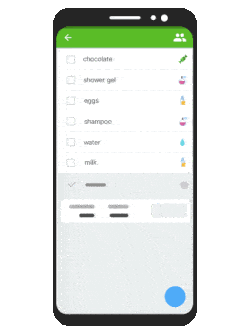
Download the Highest Rated Shopping List App
- Always with you on any device
- Buy exactly what you planned
- Make and share shopping lists together
- See items automatically grouped into categories
Do I also need to exercise?
Absolutely!
You’ll certainly be reaping some benefits from merely making adjustments to your diet. But being active will really help with weight loss.
However, we don’t mean that you should start spending hours at the gym and/or training for a marathon straight off the bat. Doing 150 minutes of moderate exercise a week (around 30 minutes per day) will be enough to keep you on the straight and narrow. This can be done in the form of:
- Doing some extra brisk walking – this can be achieved by doing things such as going to a transit stop further away from your usual, as well as making time to take a leisurely walk
- Dancing – it’s not only great fun, but it’s also great exercise. Even a gentle waltz gets the blood pumping and your feet moving. Consider taking a dancing course or attend some dance socials.
- Cycling – switch your bus for a bike. It helps you work up a sweat on your way to work, even if you’re speed isn’t quite that of Bradley Wiggins. It might also save you money in the long term over public transport. However, cycling is not cost-free, and you’ll need to factor in safety equipment, maintenance, and repairs into your monthly budget.
Your Healthy Grocery List
Now that we’ve gone through the rhyme and the reason for what changes you need to create your own healthy grocery list. You can also download a free printable version.
Meat
Fish
Produce
Carbs
Dairy
|
Oil & Fat
Sweets
Snacks
Drinks
|
Are you already making a healthy grocery list? Do you have any other suggestions of other healthy foods? Do you have any suggestions for tasty meat or milk alternatives? Care to share some of your favorite healthy recipes? Let us know in the comments.
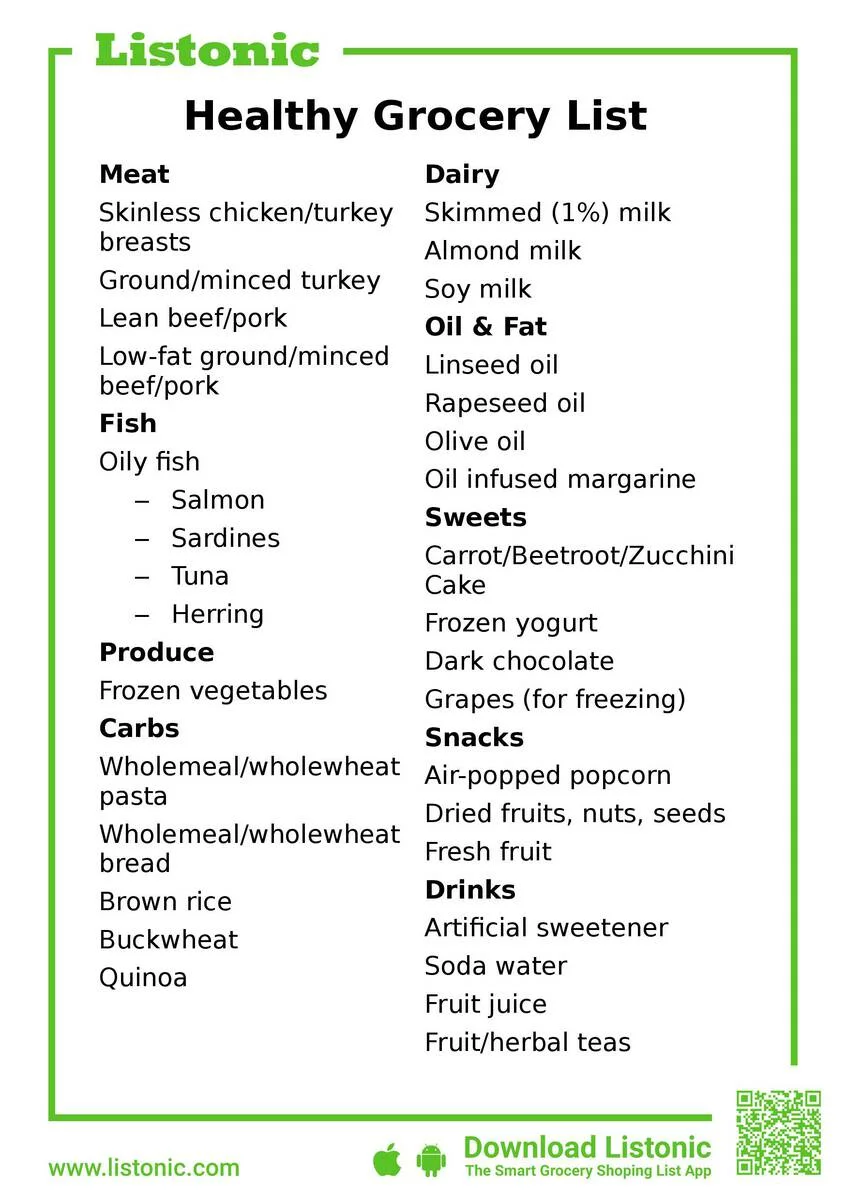
Healthy grocery list PDF
You can also download Healthy Grocery List template PDF
